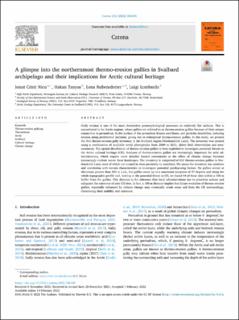| dc.description.abstract | Gully erosion is one of the most destructive geomorphological processes on relatively flat surfaces. This is exacerbated in the Arctic regions, where gullies are referred to as thermo-erosion gullies because of their unique connection to permafrost. As the surface of the permafrost freezes and thaws, soil particles destabilize, inducing erosion along preferential incisions, giving rise to widespread thermo-erosion gullies. In this study, we present the first thermo-erosion gully inventory in the Svalbard region (Nordenskiöld Land). The inventory was created using a combination of available aerial photographs from 2009 to 2011, direct field observations and measurements. The spatial distribution of thermo-erosion gullies is then exploited to investigate potential threats to the Arctic cultural heritage (CH). Analyses of thermo-erosion gullies are increasingly important for artic administrations, which require more detailed hazard assessments as the effect of climate change becomes increasingly evident across these landscapes. The inventory is comprised of 810 thermo-erosion gullies in Nordenskiöld Land, most of which are located in close proximity to coastlines. We assess the inventory size statistics and correlation with terrain characteristics to investigate potential predisposing factors. No gullies occurs at elevations greater than 200 m a.s.l., but gullies occur up to a maximum steepness of 37 degrees and along the whole topographic profile and, looking at the potential threat to CH, we found 44 of these sites within a 100 m buffer from the gullies. This distance is the reference that local administrations use to prioritize actions and safeguard the existence of artic CH sites. In fact, a 100 m distance implies that future evolution of thermo-erosion gullies, especially enhanced by climate change may eventually erode away soil from the CH surroundings, threatening their stability and existence. | |
